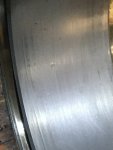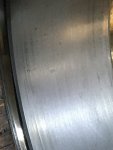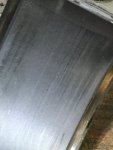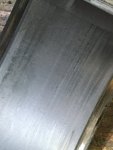ldmack3
Well-known member
- 849
- 1,740
- 93
- Location
- N. Central Idaho
Do you pull the studs to clean up the block or just work around them? Easier to do if pulled don't think it is necessary.
Steel Soldiers now has a few new forums, read more about it at: New Munitions Forums!

I'd pull them out and check them, then clean the threads up real good. Use a wire wheel to get into the threads. Or better yet replace them with "ARP" studs. Also use a "counter-sink" bit to cut an edge on the bolt holes. This cuts back the deck that gets raised when you use studs. A single flute 7/8" counter-sink bit should work fine. Also if you do decide to reuse the original studs use some "Loctite" on the threads. I know most people say not to use anything on the studs, just allow them to "float free" . I've found this to be a problem especially on a budget rebuild using old studs. Don't tighten the studs down tight though. With the "Loctite" you just hand tighten then tighten a little bit more. After installing the heads, use a good thread lube on the studs. Like mentioned before, "ARP" makes a great thread lube.Do you pull the studs to clean up the block or just work around them? Easier to do if pulled don't think it is necessary.
You can work around them to clean the block. Cover up any port or gap with a piece of stiff paper or use tape if you're scraping pieces of the old gasket off and don't want anything to go into one of those holes/ports.Do you pull the studs to clean up the block or just work around them? Easier to do if pulled don't think it is necessary.
I've used that trick before. The only problem we had was the head ripped out several studs when it cut loose. If you do decide to use this method, make sure the nuts are loosened to the same degree on each stud. Seems we had a couple odd nuts tighter than the other ones. These two studs took the full force of the head blowing off. Didn't realize how bad they were until it came time to reassemble the heads. The two studs wouldn't tighten down. They just continued to pull up. After removing the two offending studs we saw what had happened. We ended up removing the head and drilling out the stud hole and installing a "HeliCoil" . I don't recommend using "HeliCoils" in that position. Now a good "Keen-Sert" might have worked better.I used to loosen the head bolts , remove the rockers and crank the engine over to remove a stuck head.
It was quite the learning experience, thats for sure. I would hate to admit how long i spent looking over that rear head looking for a hidden bolt or something else I was missing that was holding it down.@fleetmech Thank you for that fascinating insight! I would not have thought that a blown head gasket can "heal itself". But that is, essentially, what happened. You would not have been any the wiser, had you not decided to pull the rear head; it had no noise, no compression loss and no indication that the head gasket was, in fact, busted. With hardened carbon clogging everything up, that head might have sealed for decades to come. Who would have thunk!
After hauling my 2nd load of topsoil at 3,600 lbs. I noticed white smoke coming from the slobber tube. I've checked for the signs of water in oil and see none. FDC bypass done. No whiteish foam on the valve cover oil cap, no increasing oil level, no decreasing water level. So suspect it is blow by. The smoke only appears as the engine warms up and it has been run pretty regular so not condensation.
I have been watching some slight leakage between head and block in 2 places and now three. Aft of #6, #1 exhaust manifold attach and now front right corner.
Starts easily, runs smooth and strong as far as I know.
So I am looking at pulling and rebuilding the heads for the leaks and to inspect the cylinders. It turns out I had a bad EGT indicator (replaced some weeks ago) but am unsure how hot my temps have been. Got a bad feeling on this. With the new indicator it did bump 1300F for a sec until I let off and downshifted on this last load.
All that being said if I pop the heads and see something I can't live with, depending on cost I would like to swap in an LDS465-1A or 2. (More power!)
Between a “good removed” LDT and a govt refurbished LDS it could run $2,000 to $6,500 + shipping. OUCH! I've also a tranny issue to correct. $$
With a good removed LDT I feel like I should at least pop the heads and inspect.
Coming off the road to my driveway is a sharp switchback so I don't think a wrecker could get around it should it break down on the road. I have to do a 3 pt turn with just the truck.
I'm looking for opinions, advice and suggestions from those with more experience in this area.
Thanks all!
I completely understand, I didn't realize there were piston kits, so that's a plus. You recall what the piston kits were going for? Couldn't you just get a loan and put it as a student loan so you don't have to pay it backI'd replace all the pistons and sleeves if I had the money. Piston kits are available as well as the upper and lower rod bearings. I don't like not replacing everything already being there, but it adds up so quick. Still waiting on report back on my heads.
And I haven't even opened the tranny yet to see where that chip came from. Another post.
$110 +rod bearingsI completely understand, I didn't realize there were piston kits, so that's a plus. You recall what the piston kits were going for? Couldn't you just get a loan and put it as a student loan so you don't have to pay it back
I thought he "blew" his head gaskets ? I didn't read where he has had continuous blowby. In that case I agree with your uncle. You need to remember that the MultiFuel has one of the highest compression ratios of any diesel engine out there. That means any problem with piston rings or valve guides, or worn piston liners can create severe blowby. This is why the MultiFuel engine always seems to have smoke coming out the exhaust/crankcase on start-up and hard acceleration. Kind of the "nature of the beast" thing.Something to consider. My uncle has been working on his suv for the past week at my house (he can't work on vehicles where he lives and his shop told him no as they need space for their equipment), anyways,when he takes a break, we'll shoot the. As we talked about my deuce, I told him it had some blowby, as in, continuous blowby. No major loss of oil, coolant,starts and runs well, and stays at operating temperature. Keep in mind my uncle is not a do it yourselfer, he's a master mechanic and works on industrial Cummins for cement trucks and various equipment for an industrial company, so I will listen to what he says as much has ring true.
According to him, my heads are fine, as in I don't have a head gasket failure other than it seeps oil, but apparently that's due to increased crank case pressure so that's expected. If it has a puff of blowby right after start up but fades away, it's the valves, minor blowby here and there is normal, excessive can mean a bad valve as in it no longer seals at all, or the rings are worn. In my case he highly suspects my rings are worn or the sleeves or both. Apparently this will allow a steady amount of blowby, more than normal to puff continuously as mine does. So for the OP, if you have the heads off, perhaps your blowby issue may continue with the current set of piston rings and sleeves. Adding a new head gasket will work for a while, but apparently the crankcase pressure will cause the heads to weep oil again and the blowby could still be there.
Is this true or 100% correct? Maybe? Maybe in my case and not for the OP, but it's something to consider anyways.
Perhaps RustyStud or another diesel mechanic could weight in and verify or disprove?
I mention this, because if this is a very likely possibility, perhaps just a head gasket and a cracked piston is not the fix that's needed and the work was done mostly for nothing? As others who may have this same issue and want to know why according to the symptoms they see, I'd hate for someone to do a head gasket replacement only for the blowby to still be there and the gasket weeps oil again. I'm not sure if you can just buy the rings for the pistons as long as the sleeves seem to be in good condition, but since pistons, rings and sleeves don't appear to be an easy part (s) to get these days, almost makes me wonder if it's one of those things where you drive it till it's dead and re-power it or supply endless amounts of oil and hope for best. What do y'all think?
I've seen this happen on "farm" equipment quite a few times. In fact, my father bought a 1940 IHC TD-6 diesel dozer that had this very condition. According to the previous owner it would go through "spells" of overheating then heal itself.It was quite the learning experience, thats for sure. I would hate to admit how long i spent looking over that rear head looking for a hidden bolt or something else I was missing that was holding it down.
Considering how long it ran like that, I fully expected to find torching especially through the cutout areas, but the heads and deck apparently shrugged it off with no marks other than a bit of gasket shadow. Perhaps enough compression was lost to drop cylinder temps below the threshold for combustion? When the front one let go at Cyl #2, I definitely knew something was up.
Back to OP's truck, what do you guys think about re-torqueing? I've heard that its not necessary with the new style gaskets but I did it with mine and I'm glad I did, even though it was a bunch more work. Those nuts moved a lot after one heat cycle.
Thanks! It's hard to tell imo if the truck isn't driven often. The more often it's driven, the easier it is to notice small little changes as they happen. I've noticed as such like you mentioned. Sometimes just certain sounds catch my attention and I realize something is off, such as the time my belts snapped. Heard the belts break, wasn't sure what it was and watched the gauges over the next ten minutes and sure enough, the temp gauge wasn't lying. The blowby issue I have, I think is why my oil gauge may be bouncing like it does. It's steady when idling, accelerating it bounces and I noticed that about 4-5 months after I got the truck. About the same time as the blowby seemed to be continuous. No puff of smoke other than what's normal from the exhaust, no instant puff of white smoke from the slobber tube, so I'm pretty sure in my case, my truck has rings/sleeves out of spec. Sucks but it's worth rebuilding or re-powering imo.I thought he "blew" his head gaskets ? I didn't read where he has had continuous blowby. In that case I agree with your uncle. You need to remember that the MultiFuel has one of the highest compression ratios of any diesel engine out there. That means any problem with piston rings or valve guides, or worn piston liners can create severe blowby. This is why the MultiFuel engine always seems to have smoke coming out the exhaust/crankcase on start-up and hard acceleration. Kind of the "nature of the beast" thing.
That being said, you can minimize anything above the "standard" blowby by careful and really almost continuous monitoring of the engines performance. If you feel the power is low like you're shifting into a lower gear sooner than usual for that hill, then start taking notes. The military had each driver keep a "journal" for their truck they were assigned too. That way the mechanics could look at it and get a feel for what was going on in the engine.
So, let's say you're driving on your normal route to your favorite hunting cabin when you start to feel the engine getting weaker after that hill you just went up. The outside temperature is in the high 90's and your engine temp was higher than normal before you went up that hill. During the climb you had to push the throttle more than usual. That should go into your journal. That could have been when you started to "blow" the head gasket. Then latter on you "finished" the job days later on another hill.
The outside temperature was lower the day you thought you blew the head gasket, so you didn't connect the radiator/thermostat/water-pump problem you actually have to the problem you have now.
Getting back to the "blowby" issue. If you start to experience more than usual smoke, you need to start looking at how the engine has been operating up to now. This also includes oil consumption guys !
That is a very important factor in a engine's life especially diesels. That is why you need to follow the militaries guidelines on the "daily" operation of your Deuce. "Prestart" and "after" operations checks.
If more people did this there would be far less problems mentioned here. You would catch the problem before it became a problem. Do the maintenance.





